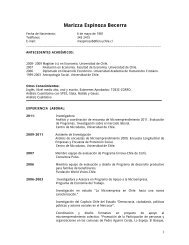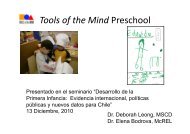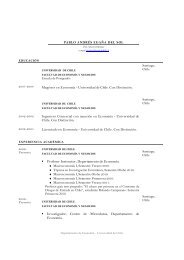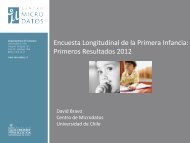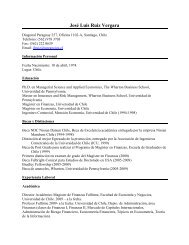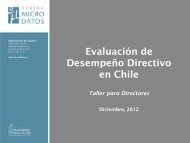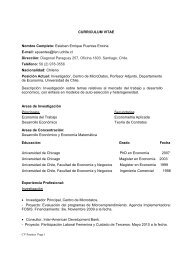Introducción a Series de Tiempo Univariadas - Centro Microdatos
Introducción a Series de Tiempo Univariadas - Centro Microdatos
Introducción a Series de Tiempo Univariadas - Centro Microdatos
You also want an ePaper? Increase the reach of your titles
YUMPU automatically turns print PDFs into web optimized ePapers that Google loves.
-20000 -10000D.sa010000 20000Introducción a <strong>Series</strong> <strong>de</strong> <strong>Tiempo</strong> <strong>Univariadas</strong>December 31, 20102000m1 2002m1 2004m1 2006m1 2008m1 2010m1fechaNuevamente, utilizaremos la segunda versión <strong>de</strong>l test, ya que no está claro si tiene algún <strong>de</strong>svío(drift) <strong>de</strong> ruido blanco. Lo que si está claro, que la serie en primera diferencia no presentaten<strong>de</strong>ncia.dfuller sa, regress drift lags(0)Dickey-Fuller test for unit root Number of obs = 127----------- Z(t) has t-distribution -----------Test 1% Critical 5% Critical 10% CriticalStatistic Value Value Value------------------------------------------------------------------------------Z(t) -3.165 -2.357 -1.657 -1.288------------------------------------------------------------------------------p-value for Z(t) = 0.0010------------------------------------------------------------------------------D.sa | Coef. Std. Err. t P>|t| [95% Conf. Interval]-------------+----------------------------------------------------------------sa |L1. | -.149419 .0472053 -3.17 0.002 -.2428441 -.0559939|_cons | 3583.703 1200.686 2.98 0.003 1207.396 5960.011------------------------------------------------------------------------------En este caso, también se rechaza la hipótesis nula <strong>de</strong> que la serie cosecha <strong>de</strong> salmones tenga unaraíz unitaria, y po<strong>de</strong>mos afirmar que la serie es estacionaria.67



